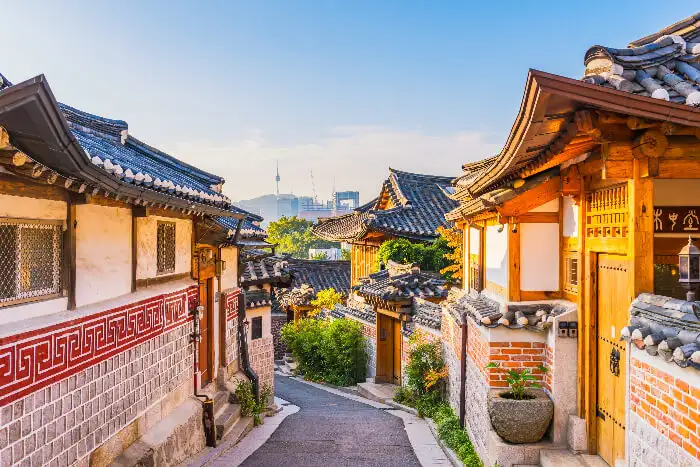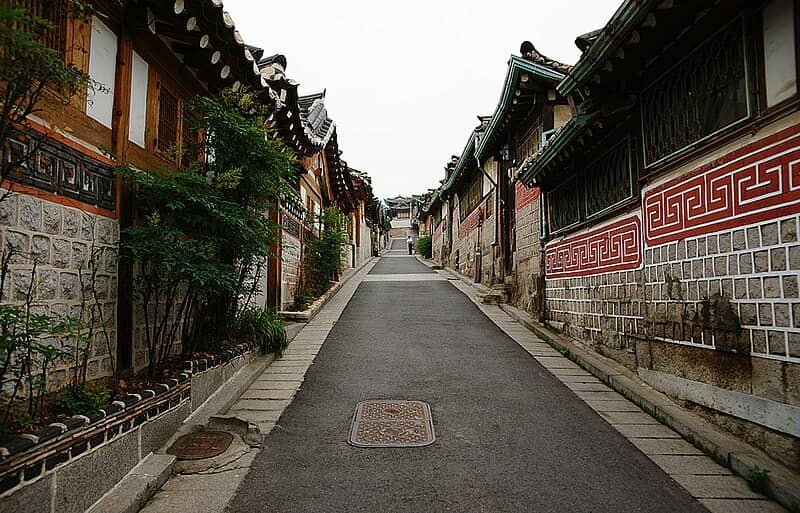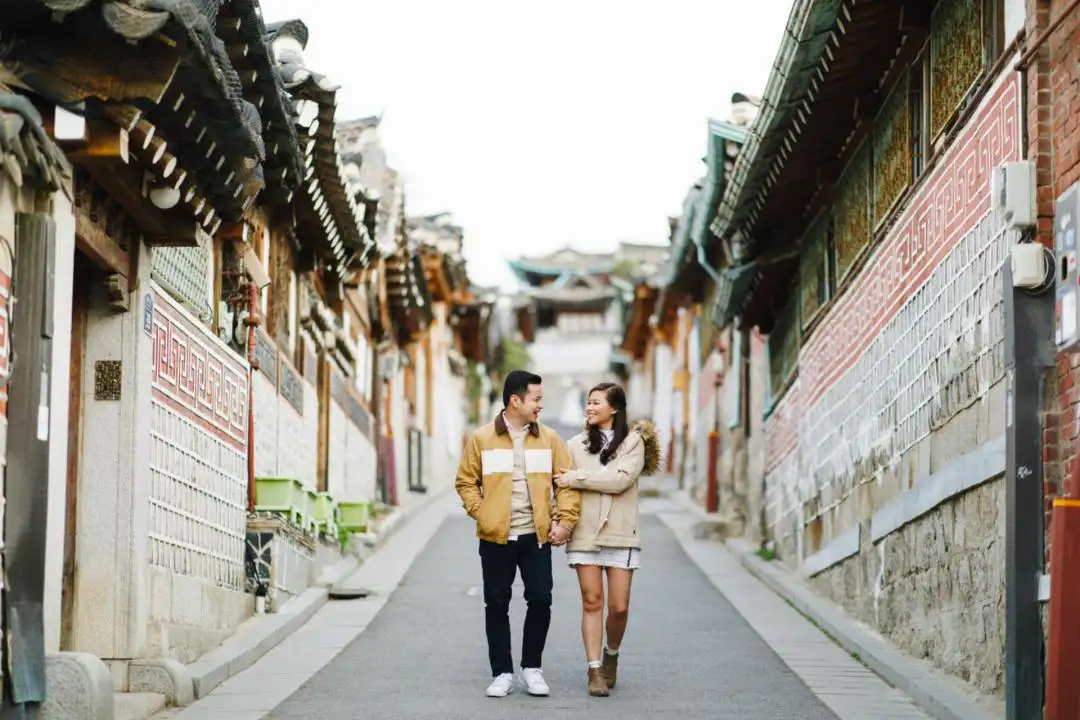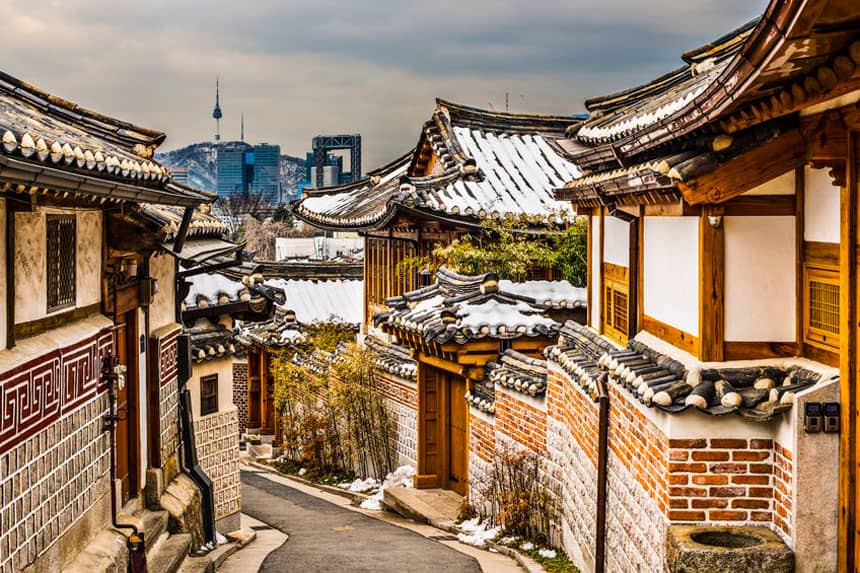Physical Address
304 North Cardinal St.
Dorchester Center, MA 02124
Physical Address
304 North Cardinal St.
Dorchester Center, MA 02124

Immerse yourself in the heart of Korean tradition at Bukchon Hanok Village. Nestled between two palaces in Seoul, this preserved area offers a rare glimpse into centuries-old Hanok houses. You’ll wander through winding alleys, soak up stunning views, and discover rich cultural experiences. From craft workshops to mouthwatering street food, Bukchon holds countless secrets waiting for your discovery. So, lace up those walking shoes – an unforgettable journey back in time awaits you.
You’d be interested to know that Bukchon Hanok Village has a rich history dating back to the Joseon Dynasty, making it a living museum of Korea’s traditional culture. This village origin is intertwined with historical transformations that have occurred over centuries. Located in central Seoul, between Gyeongbokgung Palace and Changdeokgung Palace, this captivating neighborhood was once home to high-ranking government officials and the aristocracy.
As you stroll through the winding alleys of Bukchon Hanok Village, you can’t help but appreciate the intricate details of these traditional Korean houses known as ‘Hanoks’. Their design is not just aesthetic but deeply symbolic; every element reflects philosophical principles like harmony with nature and balance. These distinctive features have been preserved through meticulous restoration efforts despite modernization pressures.
Over time, this historic neighborhood underwent several transformations. From being a symbol of nobility during the Joseon era to becoming a hub for artisans in the 20th century, these changes are evident in its diverse architectural styles and cultural spaces. The village even endured harsh periods during Japanese colonization and post-war modernization when many Hanoks were destroyed or altered significantly.

Despite these challenges, Bukchon Hanok Village stands today as a testament to Korea’s enduring cultural heritage. It serves as an educational space where locals and tourists alike immerse themselves in traditional Korean arts and crafts workshops or tea ceremonies at local teahouses. Its picturesque vistas offer unique insights into how contemporary Seoul coexists with its vibrant past without compromising on either side’s authenticity or charm. Thus, Bukchon Hanok Village remains an invaluable window into Korea’s rich historical tapestry.
Despite its status as a major tourist attraction, Bukchon Hanok Village is still home to a lively community of residents. The village offers a glimpse into everyday life as it was centuries ago, yet it is very much a living community today. Residents have embraced their role as custodians of tradition while navigating the challenges of tourism. They actively participate in efforts aimed at preserving the cultural integrity of the area, such as guided tours and cultural workshops that emphasize respectful interaction with visitors.
The village association actively works to maintain a balance between tourism and the daily lives of its residents. Programs designed to educate visitors about appropriate behaviors, such as respecting private spaces and maintaining tranquility, are in place to foster mutual respect. Community events organized by residents further strengthen this community connection, allowing visitors and locals to engage in dialogues about culture and history, ensuring the essence of Bukchon is preserved in the face of growing global interest.
In your exploration, you’ll notice that traditional Korean houses, often referred to as ‘hanoks,’ showcase a unique and intricate architecture. Hanoks are not just buildings; they’re living embodiments of Korea’s cultural heritage with each design element having its own story and symbolism.
There are three key principles underpinning the design of Hanoks:
Modern adaptations of Hanok have embraced these time-tested philosophies while integrating modern conveniences such as updated plumbing, electrical systems, and more efficient ondol heating systems. However, at their heart remains an unwavering commitment to harmonize with nature.
As you wander through Bukchon Hanok Village, take note of how each hanok seems to breathe with life – its wooden beams arching gracefully upwards like outstretched arms reaching up towards the heavens, walls made from natural materials such as clay or stone blending seamlessly into the landscape around them. You’re not just looking at buildings – you’re witnessing centuries-old wisdom about space utilization, sustainability and respect for nature distilled into architectural form. This distinctive blend might inspire thoughts on how modern urban spaces could foster deeper connections between individuals and their surrounding environment without sacrificing comfort or efficiency.
The preservation of Bukchon Hanok Village has had a significant impact on modern Korean architecture. Contemporary architects often draw inspiration from the hanok style, incorporating elements such as natural materials, geometric simplicity, and harmony with the environment in new buildings. Notably, developments in the upscale neighborhood of Samcheong-dong reflect these influences, where modern residences and commercial spaces are designed with nods to traditional aesthetics.
Architectural conservation efforts in Bukchon have also prompted discussions on urban planning and the value of preserving historical sites in rapidly modernizing cities. With an increasing interest in eco-friendly architecture, many modern designers are exploring ways to incorporate traditional spatial designs and passive heating and cooling strategies derived from hanoks into new developments. Such approaches are not only aesthetic but also contribute to sustainable building practices, providing models for balancing development with heritage conservation in urban environments.
This fusion creates a unique architectural landscape, where the past and present coexist harmoniously. It has also spurred a renewed interest in sustainability, with many projects emphasizing eco-friendly practices reminiscent of hanok’s original construction principles.
There’s no shortage of stunning photo ops and scenic views around every corner in Bukchon Hanok Village. This traditional Korean village, nestled between Gyeongbok Palace, Changdeok Palace, and Jongmyo Shrine in Seoul, offers a unique perspective into the city’s rich history and culture. Each alleyway is lined with hanoks—traditional Korean houses—providing an atmospheric backdrop for your photos.
Sunrise photography here is particularly breathtaking. The soft morning light illuminating the tiled roofs of the hanoks creates a serene ambiance that can’t be replicated anywhere else. Imagine capturing the moment when dawn breaks over the rooftops as you stand on one of Bukchon’s hilltops, overlooking this timeless scene. As you begin your day amidst this spectacle of nature meeting tradition, you’ll feel connected to Korea’s ancient past.
As day turns into night, Bukchon Hanok Village transforms into an enchanting wonderland. The nighttime vistas are awe-inspiring as ambient lights from within each hanok create a warm glow against their wooden exteriors while stars sparkle overhead. Capturing these moments make for unforgettable memories which are sure to leave anyone who sees them mesmerized by their beauty.
Walking through Bukchon Hanok Village isn’t just about sightseeing – it’s about experiencing centuries-old traditions firsthand while appreciating its beauty through your lens. Every click of your shutter will capture not just an image but a piece of Korea’s soul that transcends time itself – making every picture truly worth a thousand words.
As you meander through these culture-infused streets, you’ll find yourself stepping back in time, surrounded by the rich heritage of traditional Korean life. Bukchon Hanok Village isn’t just a cluster of old houses; it’s a living museum that breathes life into the history and traditions of Korea. The well-preserved hanoks – traditional Korean houses – with their graceful curved roofs and sturdy wooden beams, stand as reminders of an era long gone but not forgotten.
Embarking on your journey through Bukchon Hanok Village allows for authentic cultural immersion in ways you wouldn’t expect. Here are three aspects to look forward to:
These experiences bring alive the essence of traditional Korean culture amidst modern Seoul’s hustle-bustle.
Don’t miss out on exploring alleyways off the main path where charming cafes, art galleries, and unique boutiques reside. Each turn uncovers another layer of this cultural gem nestled within the heart of Seoul. As day turns into night, watch as lanterns cast warm glows over stone pavements illuminating stories from years past.
Through this exploration, you’ll realize that Bukchon Hanok Village isn’t just about preserved buildings; it’s about reliving forgotten tales steeped in tradition while creating your own memories within these ancient walls.
Throughout the year, Bukchon Hanok Village hosts a variety of cultural events and festivals, offering visitors an opportunity to experience traditional Korean culture in its natural setting. One of the standout events is the Bukchon Cultural Festival, held annually in the autumn. This festival showcases a variety of performances, including traditional Korean dance and music, as well as interactive workshops where participants can engage with crafts and cultural practices unique to this region.
Visitors may also enjoy seasonal tea ceremonies and culinary demonstrations that explore Korean gastronomy. These events truly highlight the rich cultural diversity of Bukchon, providing unique encounters with Korea’s rich heritage.
Another notable event is the Hanbok Day, which sees participants wearing traditional Korean garments while engaging in a variety of public performances and parades. This celebration provides a lively insight into Korean sartorial traditions while encouraging visitors to participate in the festivities. During major Korean holidays, such as Chuseok and Lunar New Year, the village hosts special events that bring local customs to life. Visitors can enjoy traditional games, music, and dance performances that capture the spirit of these significant cultural celebrations.

You’ll find traditional craft workshops dotted around, offering you a chance to learn age-old arts like knot tying or fan making. These cultural treasures are nestled amidst the narrow lanes and alleys of Bukchon Hanok Village. They’re not just shops selling crafts, but living museums where you can witness firsthand the dedication and skill required in preserving these ancient techniques.
Craft material sourcing is an integral part of this process, ensuring that each piece produced is authentic and true to its origins. You might encounter artisans meticulously selecting mulberry bark for hanji papermaking or silk threads dyed with natural colors for their intricate embroidery work. This careful selection of raw materials underpins the quality and integrity of each craftwork.
A visit to one of these workshops provides more than just a glimpse into Korean culture; it’s an immersive experience filled with stories woven into every artifact. Each workshop is a testament to technique preservation – from pottery throwing at a master potter’s wheel to creating delicate metal inlays for traditional jewelry – every movement is steeped in years of practice and tradition.
At these workshops, you have the chance to try your hand at crafting something yourself under expert guidance. Whether it’s creating your own personalized hanbok (traditional Korean dress) or painting a minhwa (folk painting), there’s no shortage of opportunities to test your creativity while gaining insight into Korea’s rich cultural heritage.
So don’t just wander through the streets of Bukchon Hanok Village soaking up its charm; immerse yourself fully by joining one of its many craft workshops. It’s not merely about learning new skills, but participating in sustaining centuries-old traditions that shape Korea’s distinct identity today.
As you complete your journey through the traditional craft workshops, another form of artistry awaits you in Bukchon Hanok Village – the art of tea. Let’s navigate away from the bustling artisan shops and immerse ourselves in a more serene experience at the village’s traditional tea houses.
Step into one of these charming establishments and be instantly transported back to a simpler time. The rustic hanok structures, with their low wooden tables and floor cushions, set an intimate stage for experiencing Korea’s rich tea culture. Each tea house offers a unique atmosphere that embodies tranquility, inviting visitors to unwind while savoring thoughtfully prepared teas.
Tea ceremonies are a significant part of Korean culture and play an essential role in these traditional tea houses. These ceremonies are not merely about drinking tea but are rather spiritual journeys where every movement is purposeful and each sip is savored mindfully. As you watch the intricate process unfold before your eyes, you’ll gain insights into this revered tradition that has been passed down for centuries.
Explore various tea types available during your visit. From delicate green teas like Nokcha to robust black teas like Hongcha or aromatic herbal infusions such as Omija Cha or Yujacha, each brew tells its own story. The ritualistic preparation enhances each flavor profile, providing an immersive sensory experience.
Bukchon Hanok Village’s traditional tea houses offer more than just refreshments; they represent Korea’s enduring love for simplicity and harmony with nature. So take this opportunity to pause amidst your exploration—pull up a cushion, admire the view outside the paper windows, sip on some finely brewed tea and soak in this timeless slice of Korean heritage.
After relishing the tranquility of traditional tea houses, it’s time to explore the vibrant world of local cuisine and street food in Bukchon Hanok Village. This quaint village not only preserves the architectural charm of its hanoks but also guards culinary traditions while embracing novelty.
Bukchon is a haven for food enthusiasts where you can witness:
As you explore Bukchon’s winding alleys brimming with history and culture, let your senses guide you through this gastronomic journey steeped in tradition yet invigorated by innovation. Each bite is an echo of the past meeting the present – a testament to Korea’s rich culinary heritage evolving over time but still deeply rooted in its core values. So don’t just sightsee around Bukchon Hanok Village; taste its vibrant life too!

After relishing the mouthwatering local cuisine and exploring the vibrant street food scene in Bukchon Hanok Village, you might find yourself yearning for a more immersive cultural experience. And what better way to truly embrace Korean tradition than by slipping into a beautifully tailored hanbok?
As you wander through the charming alleyways of Bukchon, you’ll be drawn to the numerous shops offering Hanbok rental options. Each shop is a riot of color with racks full of these traditional Korean dresses in every hue imaginable. From royal emerald greens and vibrant magenta pinks to soft pastel colors that evoke a sense of tranquil beauty. You can choose from a variety of styles – some reminiscent of royal court attire complete with ornate headpieces, others simpler but equally captivating.
Once adorned in your chosen hanbok, it’s time to step out onto the cobblestone paths and pose against the backdrop of centuries-old hanoks (traditional Korean houses). But remember – while taking photographs is encouraged as part of this unique cultural experience, there are certain photo etiquette rules that should be observed. Respect private property by not posing on doorsteps or peering into windows and always seek permission when photographing locals.
The sun begins to set over Bukchon, casting long shadows across its tiled rooftops as you walk amidst history cloaked in tradition. The whole village becomes an incredible living museum under your feet – one where you’re not just observing but actively participating in its rich heritage. The Bukchon Hanbok Experience is more than just donning traditional attire; it’s stepping into another era entirely.
Visitors to Bukchon Hanok Village will find several amenities to enhance their experience. Information centers scattered throughout the area offer maps and brochures in multiple languages, providing guidance and historical context for self-guided walks. Guided tours led by knowledgeable locals are available and offer in-depth insights into the village’s history and architecture.
For those seeking a break, there are numerous rest areas and small cafes tucked along the winding streets, offering refreshments and scenic views. Public restrooms are also available, ensuring comfort during your exploration. While navigating the village, you’ll find that it is well-connected, with easy access to public transportation and nearby attractions.
You’re not done yet, there are plenty of nearby attractions you can explore to make the most out of your journey. Once you’ve savored the charm and tranquility of Bukchon Hanok Village, venture further afield to discover other cultural gems that resonate with Seoul’s deep history and vibrant modernity.
The village accessibility makes it easy for you to move around these places without much hassle. Plus, there are numerous accommodations available nearby catering to different budget ranges – whether you prefer guesthouses imbued with local flavor or luxury hotels brimming with top-notch amenities.
After exploring these fascinating sites close by Bukchon Hanok Village, take some time to reflect on your experiences and allow yourself to be immersed in the rich tapestry that is Seoul’s culture. You’ll find that each attraction adds another layer to your appreciation of this dynamic city’s past and present intertwining in harmonious unity.
In recent years, Bukchon Hanok Village has embraced environmental initiatives aimed at preserving its unique landscape. Restoration projects in the village prioritize the use of traditional building methods that emphasize sustainability, using locally sourced materials and techniques that minimize environmental impact.
Efforts to maintain green spaces enhance these traditional practices, ensuring that urban development does not compromise the area’s ecological balance. Waste reduction initiatives have also been introduced, encouraging visitors and residents to practice recycling and composting, significantly reducing waste generation in the area. These efforts highlight Bukchon’s dedication not only to cultural preservation but also to environmental stewardship.
To make your journey smoother, we’ve compiled a few practical tips for visitors. First and foremost, the travel logistics. The easiest way to reach Bukchon Hanok Village is by subway. Take Line 3 to Anguk Station, exit at Gate 2 and you’ll be just a short walk away from this historical gem nestled within Seoul’s bustling cityscape.
Walking around Bukchon can be quite an uphill task – literally! The village is perched on a hill so wear comfortable shoes and be prepared for some steep climbs. Remember, it’s not just about reaching the top; take time to absorb the beauty of traditional Korean architecture as you ascend.
Seasonal considerations are crucial when planning your visit. Each season paints Bukchon in unique hues but remember that winters can get bitterly cold while summers bring sweltering heat. Spring (April-May) and Autumn (October-November) are ideal times with moderate weather and stunning natural landscapes.
Be mindful of local customs and norms too – after all, Bukchon isn’t merely a tourist spot; it’s a living neighbourhood home to many Seoulites. Keep noise levels down especially during early mornings or late evenings, avoid trespassing private properties even if they look picture-perfect for that Instagram shot!
When hunger strikes, don’t miss out on sampling authentic Korean street food at one of the many stalls lining up along Gye-dong street – think spicy tteokbokki or sweet hotteok pancakes.
Always carry cash as most small businesses do not accept credit cards. And lastly, don’t forget to pick up a map from the tourist information centre near Anguk Station – it lists key sites in English making navigating easier through this maze-like village!